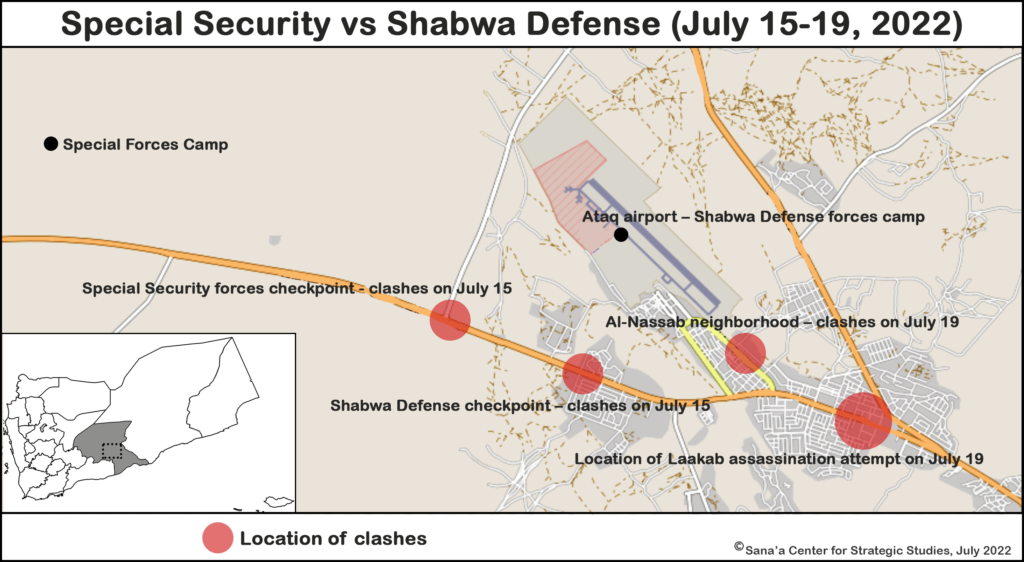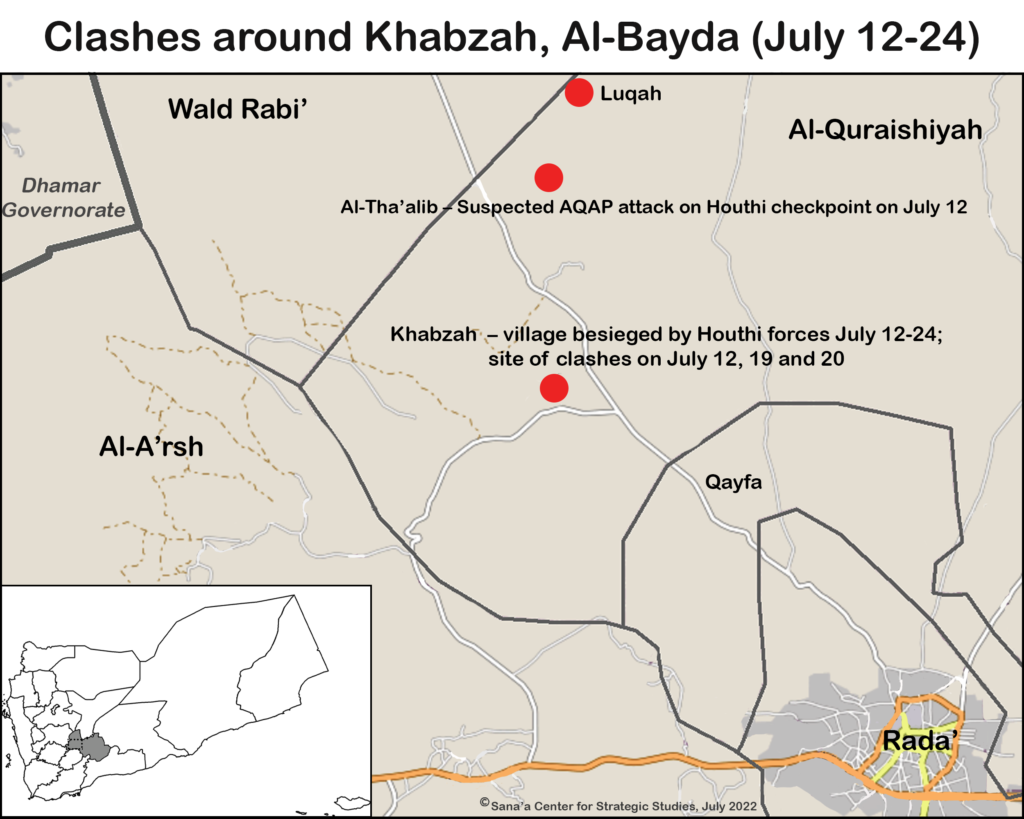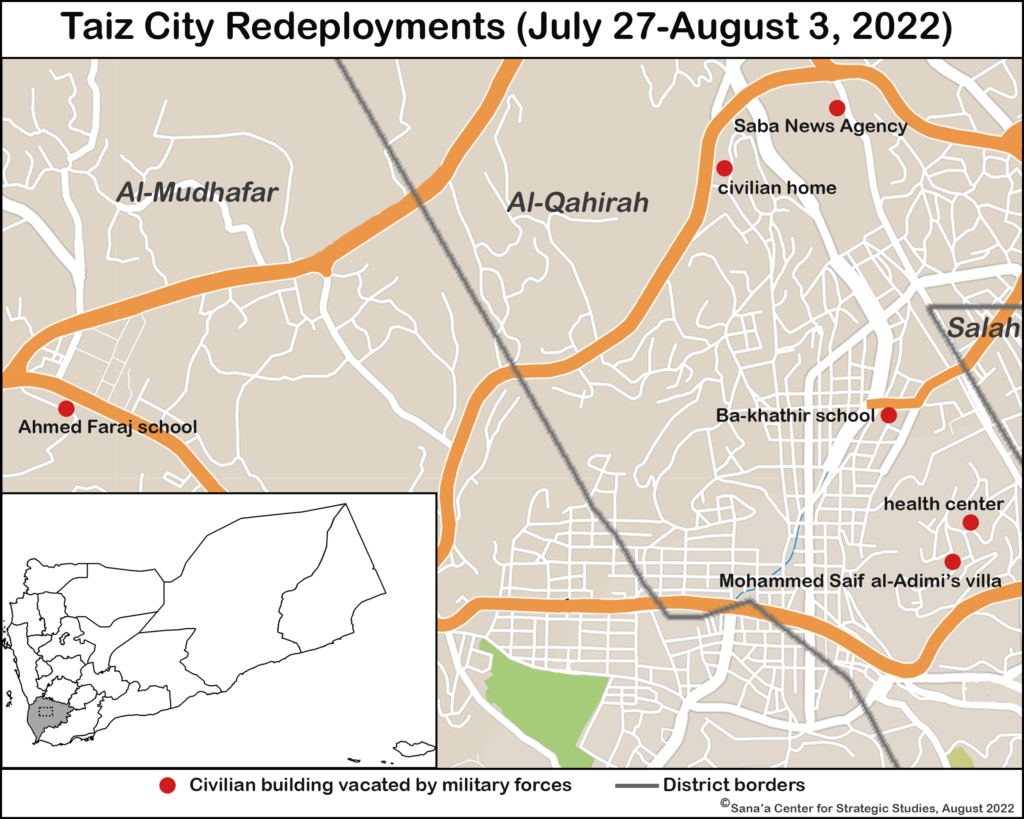Islah-affiliated commander of the Special Security forces in Shabwa, Brigadier General Abd Rabbo Laakab, survived an assassination attempt by members of the UAE-backed Shabwa Defense forces in Shabwa governorate. Laakab’s convoy was ambushed in Ataq city, the governorate capital, on July 19; two members of the Special Security Forces were killed, and two others were wounded in the attack.
The attempt was preceded by orders to replace Special Security Forces commanders and a series of clashes between members of the Shabwa Defense forces and Special Security forces in Ataq. On July 15, clashes erupted between Special Security forces manning the Al-Kahraba checkpoint in the village of Gul al-Aadh western Ataq city, and the Shabwa Denfese forces, who were prevented from entering the capital. Two members of the Shabwa Defense forces and a civilian were injured. On the same day, an argument led to clashes at the ring road checkpoint manned by the Shabwa Defense force in the Al-Sawda area, western Ataq city, and members of the 1st Battalion of the Ataq Military Axis, commanded by Ahmed Lashqam al-Barassi. No injuries were reported.
On July 19, clashes at another SDF checkpoint, in the Al-Nassab neighborhood in central Ataq city, erupted when soldiers attempted to prevent Special Security forces members from escorting four armed plainclothes individuals into the city who refused to be searched. Two SDF members were wounded. The same day, the Shabwa Defense forces attempted to arrest members of a military unit affiliated with General Laakab in the Al-Asima neighborhood of western Ataq city. Two Shabwa Special Security forces were killed and one was wounded.
In an effort to ease tensions, Shabwa Governor Awadh bin al-Wazir al-Awlaki suspended Laakab and Wajdi Baoum, commander of the Shabwa Defense forces 2nd Brigade, pending an investigation. The events in Shabwa were discussed during a PLC meeting on July 24 headed by Rashad al-Alimi, who authorized Shabwa’s governor to take action to stabilize the situation.

Houthis Battle Local Tribes in Al-Bayda
Houthi forces laid siege to the village of Khabzah in Al-Bayda governorate on July 12 and fought with local tribal forces following an attack on a Houthi checkpoint. The conflict began on July 12, after gunmen from the Luqah area in Al-Quraishiyah district, suspected of belonging to Al-Qaeda in the Arabian Peninsula (AQAP), attacked the checkpoint at the entrance to the Al-Tha’alib area of Khabzah. The gunmen killed three Houthi fighters and seized their weapons before fleeing deeper into the village, according to tribal and local sources. In response, Houthi forces besieged Khabzah and called in reinforcements from Sana’a. After a local mediation approved by the office of Houthi leader Abdelmalek al-Houthi, the villagers issued a statement saying they did not condone the checkpoint attack, leading Houthi forces to step back and wait outside the village for the fugitives to be sent out. When they did not emerge the siege was reimposed and armed clashes resumed. On July 12, two Houthi fighters were killed and four were wounded, and on July 19-20, four tribal fighters, a woman and a child were killed. Local mediation resumed after the Al-Wahbi tribe sent 20 of its members as ‘hostages’ to the Houthis, a common show of good faith in tribal deconfliction negotiations, and a deal was reached on July 20 to halt the fighting and allow the wounded to be evacuated.
On July 24, Khabzah tribal sheikhs delivered 30 wanted individuals to Houthi forces in exchange for the 20 hostages. Those who were arrested were expected to be sent to Sana’a to attend indoctrination courses. Houthi forces have largely controlled Al-Bayda since 2015, though the tribal nature of the area means their rule has not gone unchallenged. The central location of the governorate provides a significant strategic advantage for whoever controls it, allowing for escalation or deescalation on fronts in eight bordering governorates.

Truce Extended But Violations Continue
The fourth month of the truce between the warring parties in Yemen saw limited fighting on the frontlines, with no territorial advances reported. The ongoing truce, declared in early April to coincide with the start of Ramadan and renewed in June, was extended for another two months on August 2. However, sporadic truce violations occurred in late July as the deadline approached, notably in Marib, Al-Dhalea, Taiz and Hudaydah governorates. Houthi forces and government-affiliated troops clashed in the Tabat Othman and Batar areas in the northwest Qa’atabah district of northern Al-Dhalea governorate, and in the western Al-Abdiyah district of southern Ma’rib governorate, as well as on Serwah frontline, west of Marib city, and in Hays district of southern Hudaydah governorate.
Residents of government-controlled areas of Taiz city continued to demand that the Houthis reopen roads after years of blockade. The reopening of the roads was a stipulation of the initial truce agreement but talks on the issue remain stalled, with the Houthis rejecting a recent UN proposal for a phased reopening.
Notable incidents in Taiz included the halt of an Eid al-Adha festival in Al-Shuhadaa Square in the Al-Ordhi neighborhood of Taiz city on July 11, after Houthi mortar shells fell nearby. There were no casualties reported. Houthi shelling on July 23 killed one child and injured 11 others playing in the Al-Rawdhah neighborhood of the city. The incident was condemned by the United Nations and several NGOs; Save the Children called it “utterly disgraceful.” The shelling occurred as General Anthony Hayward, military adviser to the UN envoy, visited the city for meetings on the security situation with Taiz governor Nabil Shamsan.
Local government commander Mohammed Abdulmalek Nasr al-Fuhaydi was killed by a Houthi sniper on July 20, during an attack on government positions on the frontlines west of Taiz city. A number of Houthi fighters were also killed. A child was shot and killed by a Houthi sniper in Al-Quhayfa village in the Maqbanah district of western Taiz governorate on July 27 – the village and the Himyar al-Jabal area are the only parts of the district which remain under government control. The same day, one child was killed and another injured in the village of Hejat Quraish in the northern Hays district of Hudaydah governorate, during shelling between Houthi fighters and the Joint Forces.
Houthi media reported on July 17 that 17 people were killed or injured in Sa’ada governorate after being shot by Saudi border guards. No further details were given. Houthi media regularly reports alleged Saudi-led coalition and government violations of the truce. Houthi authorities claimed on July 19 that coalition planes conducted an airstrike on a civilian home and Houthi positions in Al-Shamiriyah, in the Hajr Bitar area of Al-Dhalea governorate. The next day, the coalition denied the claim, stating it had not carried out any airstrikes since the start of the truce in April.
On July 20, clashes erupted on the borders of the Al-Abdiyah and Harib districts in Marib between Houthi forces and the Giants Brigades and continued into the following days. Houthi forces claimed the Giants Brigades opened fire first, sparking the fighting. No casualties or advances were reported, according to local sources. In Al-Dhalea, sporadic clashes between Houthi and government forces were reported from July 21-23, by government military and medical sources in the Tabat Othman and Batar areas, in the northwest of the Qa’atabah district. Four government-affiliated fighters were killed in the clashes, which were followed by further reports of Houthi shelling in the area.
Military Units Vacate Civilian Buildings in Taiz City
Following direct orders from now-former defense minister Mohammed Ali al-Maqdashi and National Resistance Forces leader and PLC member Tareq Saleh, the Islah-affiliated Taiz Military Axis began a systematic campaign to remove military units billeted in civilian buildings in Taiz city on July 27. Previous initiatives had failed to dislodge the troops, but the new campaign has made several arrests to enforce the decision. Saleh’s visit to the city and championing of the removal efforts are intended to garner local support for himself and the PLC.
The operation came as the armed Houthi movement staged military parades involving troops from Taiz, and relocated units to reinforce its military presence in the governorate and nearby Ibb. Should the truce falter or fail to be extended, it appears likely that the Houthis will first move on Taiz, rather than resuming last year’s offensive on the strategic resource-rich city of Marib.

Other Military & Security Developments in Brief:
- July 7: The UK announced that it had seized shipments of Iranian missiles in the Gulf of Oman, including surface-to-air missiles and engines for cruise missiles. The seizure occurred earlier in the year, and the UK said it was the first time a British naval ship had stopped a vessel carrying such sophisticated weapons from Iran. Tehran denied the report, saying it had “never transported weapons or military equipment to Yemen.”
- July 11: Security forces in Wadi Hadramawt claimed to have captured AQAP leader Fahmi Bamasfar al-Kathiri, according to local media reports. Al-Kathiri was reportedly injured in the operation.
- July 21: Gunmen from the Al-Ka’alah tribe, part of the influential Al-Sabaiha tribe that dominates Lahj’s coast, kidnapped Brigadier General Othman Nasser al-Mushoushi al-Yafei, staff general of the STC-affiliated 3rd Backup and Support Brigade, Major General Faisal Qassem al-Radami al-Yafei, and their escorts, on the coastal road in Al-Madaribah district, in the Al-Sabaiha tribal area in western Lahj governorate. Following local and tribal mediation, all detainees were released on July 25.
- July 24: Houthi forces shot and killed a civilian carrying fuel barrels in his car in the Al-Jar area of eastern Al-Hazm district in Al-Jawf governorate. Houthi police forces are seeking to prevent the entry of oil derivatives from government-controlled areas, according to local sources. Al-Khashkhash tribesmen flocked to the area to demand the killers be brought to justice.
- July 24: Unknown assailants fired a mortar shell at the Balhaf LNG facility’s airstrip, in Rudum district of eastern Shabwa, according to eyewitnesses. The identity of the attackers and motivation for the attack remain unclear.
- July 27: A hand grenade was detonated by unknown perpetrators at Top Center Mall in Al-Mansoura district of Aden, causing damage to nearby storefronts. The mall has previously been targeted by unknown assailants demanding payment from retailers.
- July 28: A man was killed by a landmine near his farm in the Hudaydah village of Al-Juraibah, in the northern Al-Zaafaran area of Al-Durayhimi district. Six people, including four children, were injured by a landmine in the Al-Jabaliyah area of southwest Al-Tuhayta district. Two of the children had tried to open the landmine after bringing it home.
- July 29: Government Information Minister Muammar al-Eryani claimed that five Houthi engineers, including at least one non-Yemeni, were killed in a large explosion, allegedly while assembling a ballistic missile in a military hangar used for drone and missile construction near Sana’a airport.
- July 29: An improvised explosive device exploded near the home of Deputy Health Minister Musleh Nasher Al-Hakam, in the Al-A’wabel area of eastern Al-Dhalea. No casualties were reported.

 اقرأ المحتوى باللغة العربية
اقرأ المحتوى باللغة العربية